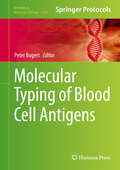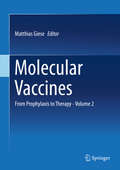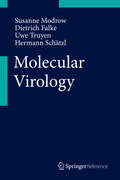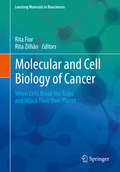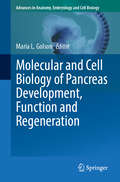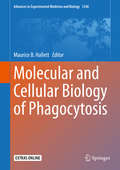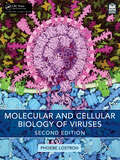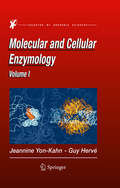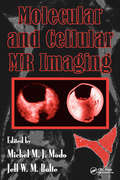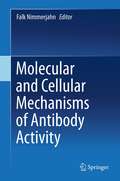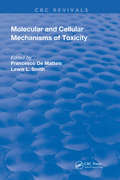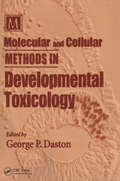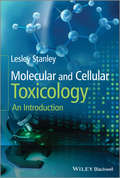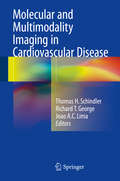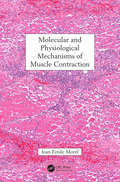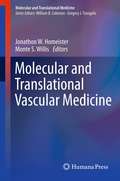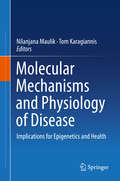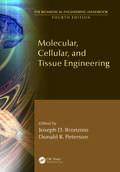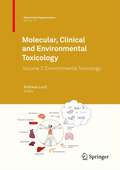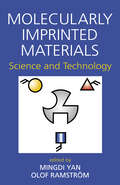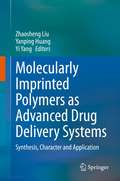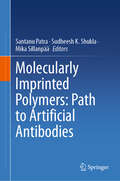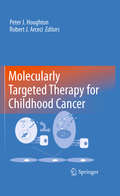- Table View
- List View
Molecular Typing of Blood Cell Antigens
by Peter BugertThis volume aims to bring together a variety of protocols useful for DNA-based typing of blood cell antigens. Protocols range from simple approaches with low technical complexity to highly sophisticated modern developments. Written for the Methods in Molecular Biology series, chapters include introductions to their respective topics, lists of the necessary materials and reagents, step-by-step, readily reproducible laboratory protocols and tips on troubleshooting and avoiding known pitfalls. Authoritative and practical, Molecular Typing of Blood Cell Antigens summarizes contributions from leading scientist in the field DNA typing for blood cell antigens.
Molecular Vaccines
by Matthias GieseThis book gives a comprehensive overview to all aspects of global molecular vaccine research. It introduces concepts of vaccine immunology and molecular vaccine development for viral, bacterial, parasitic and fungal infections. Furthermore, the broad field of research and development in molecular cancer vaccines is discussed in detail. This book is a must have for scientists and clinicians interested in new developments in molecular vaccine research and application in infections and cancer.
Molecular Virology
by Dietrich Falke Hermann Schätzl Susanne Modrow Uwe TruyenThe book gives a comprehensive overview on the knowledge of virus infection relevant for humans and animals. For each virus family the molecular details of the virus particle and the viral replication cycle are described. In the case of virus types with relevance for human and/or animal health the data on molecular biology, genetics and virus-cell interaction are combined with those concerning, pathogenesis, epidemiology, clinics, prevention and therapy.
Molecular and Cell Biology of Cancer: When Cells Break the Rules and Hijack Their Own Planet (Learning Materials in Biosciences)
by Rita Fior Rita ZilhãoThis textbook takes you on a journey to the basic concepts of cancer biology. It combines developmental, evolutionary and cell biology perspectives, to then wrap-up with an integrated clinical approach.The book starts with an introductory chapter, looking at cancer in a nut shell. The subsequent chapters are detailed and the idea of cancer as a mass of somatic cells undergoing a micro-evolutionary Darwinian process is explored. Further, the main Hanahan and Weinberg “Hallmarks of Cancer” are revisited. In most chapters, the fundamental experiments that led to key concepts, connecting basic biology and biomedicine are highlighted. In the book’s closing section all of these concepts are integrated in clinical studies, where molecular diagnosis as well as the various classical and modern therapeutic strategies are addressed. The book is written in an easy-to-read language, like a one-on-one conversation between the writer and the reader, without compromising the scientific accuracy. Therefore, this book is suited not only for advanced undergraduates and master students but also for patients or curious lay people looking for a further understanding of this shattering disease
Molecular and Cell Biology of Pancreas Development, Function and Regeneration (Advances in Anatomy, Embryology and Cell Biology #239)
by Maria L. GolsonThis book reviews recent advances in pancreatic endocrine and exocrine tissue development, function and regeneration. It provides a comprehensive overview on different aspects of beta-cell biology, including heterogeneity of function and gene expression and function, epigenetics, RNA and protein expression contributions to beta-cell specification and cell-fate maintenance. Furthermore, it covers recent progress in differentiating functional islets in vivo, environmental impacts on beta-cell development and function, and communications between various islet endocrine cells and how they contribute to the regulation of blood glucose homeostasis.The book provides a comprehensive resource for understanding the various compartments of the pancreas and is aimed at pancreas, beta-cell biology, and diabetes researchers.
Molecular and Cellular Biology of Phagocytosis (Advances in Experimental Medicine and Biology #1246)
by Maurice B. HallettPhagocytosis is the engulfment of particulate matter by cells. It is a fundamental (and probably “primitive”) cell biological process which is important in single celled organisms such as amoeba; multicellular animals including coelenterates; and in higher animals. In humans and other mammals, specialised immune cells (phagocytes) utilise phagocytosis in their crucial role of engulfing and destroying infecting microbes. Yet, surprisingly, the biophysics and biochemistry underlying the process has only become clear recently with the advent of genetic manipulation and advances in single cell imaging. In this volume, the aim is to bring together recent fundamental advances that give a clear picture of the underlying mechanism involved in phagocytosis. Not only is this an important topic in its own right, but a full understanding of the process will have a potential impact on human medicine, since as antibiotics become less effective in fight infection, researchers are looking at alternative approaches, including enhancing the “natural” immunity brought about by immune phagocytes.The aim is to provide a comprehensive volume on the topic, with separate chapters on identified recent advances, each written by the major contributors in each area. In addition, the volume will attempt to give a wider overview than is often the case in single author reviews, with an emphasis here on the cell biological understanding of phagocytosis using biophysical approaches alongside the biochemical and imaging approaches.
Molecular and Cellular Biology of Viruses
by Phoebe LostrohThis fully revised second edition of Molecular and Cellular Biology of Viruses leads students on an exploration of viruses by supporting engaging and interactive learning. All the major classes of viruses are covered, with separate chapters for their replication and expression strategies, and chapters for mechanisms such as attachment that are independent of the virus genome type. Specific cases drawn from primary literature foster student engagement. End-of-chapter questions focus on analysis and interpretation with answers being given at the back of the book. Examples come from the most-studied and medically important viruses such as SARS-CoV-2, HIV, and influenza. Plant viruses and bacteriophages are also included. There are chapters on the overall effect of viral infection on the host cell. Coverage of the immune system is focused on the interplay between host defenses and viruses, with a separate chapter on medical applications such as antiviral drugs and vaccine development. The final chapter is on virus diversity and evolution, incorporating contemporary insights from metagenomic research. The second edition has updated suggestions for primary literature to discuss along with each chapter. New to this second edition, a supplementary chapter, freely available for download, looks at how virology intersects with public health, and uses the COVID-19 pandemic as a notable example.Key Features Readable but rigorous coverage of the molecular and cellular biology of viruses Molecular mechanisms of all major groups, including plant viruses and bacteriophages, illustrated by example Host-pathogen interactions at the cellular and molecular level emphasized throughout Medical implications and consequences included Quality illustrations available to instructors New to this second edition, interactive quiz questions hosted online
Molecular and Cellular Enzymology
by Jeannine Yon-Kahn G. HervéMolecular and Cellular Enzymology addresses not only experienced enzymologists but also students, teachers and academic and industrial researchers who are confronted with enzymological problems during their fundamental or applied research. In this field there is an urgent need for training in order to meet the requirements of both research and industrial endeavours. This book consists of several levels. Practical aspects and elementary explanations are given for the benefit of non-specialists' and students' understanding. In order to facilitate the task of students, two typographies have been adopted. The main text corresponds to basic knowledge, whereas text in a smaller font provides more specialised information. Specialists will also find topics more deeply expounded with the principal bibliographic references cited. The bibliography, however, is not exhaustive; the choice includes general books and review articles as well as some specialised articles. In this book, for the first time, the different molecular and cellular aspects of enzymology are presented together. Until now, there has been no book available in which these different aspects are treated in the same volume. In addition, besides the theoretical developments, this book provides a wealth of practical information for experimentalists.
Molecular and Cellular MR Imaging
by Jeff W. M. Bulte Michel M. J. ModoThe ability of molecular and cellular imaging to track the survival, migration, and differentiation of cells in vivo as well as monitor particular gene expression in living subjects is rapidly moving from the research laboratory into daily clinical settings. The interdisciplinary nature of the field mandates a constant dialogue among molecular and
Molecular and Cellular Mechanisms of Antibody Activity
by Falk NimmerjahnThis book focuses on the function of antibodies in vivo. Recent years have seen an exponential growth in knowledge about the molecular and cellular mechanisms of antibody activity. These new results dramatically changed our view of how antibodies function in vivo. The importance of this class of molecules is demonstrated by the heightened susceptibility to infections of humans and mice with an altered capacity to generate pathogen specific antibody responses. Thus, the majority of our currently available vaccines, such as vaccines against influenza, measles and hepatitis focus on the generation of long lasting antibody responses. Recent evidence from a variety of in vivo model systems and from human patient cohorts has highlighted the exclusive role of cellular Fc-receptors for certain immunoglobulin isotypes and subclasses. With the recent discovery of a human Fc-receptor for IgM all different human immunoglobulin isotypes now have a cellular receptor, providing a feedback mechanism and link between antibodies and the cellular components of the immune system. Moreover it has become clear the complement and Fc-receptor system are tightly connected and regulate each other to ensure a well balanced immune response. Among the immunoglobulin isotypes IgG plays a very important protective role against microbial infections and also as a therapeutic agent to kill tumor cells or autoantibody producing B cells in autoimmune disease. Transfer of our knowledge about the crucial function of Fc-receptors has led to the production of a second generation of therapeutic antibodies with enhanced binding to this class of receptors. Binding of antibodies to Fc-receptors leads to the recruitment of the potent pro-inflammatory effector functions of cells from the innate immune system. Hence, Fc-receptors link the innate and adaptive immune system, emphasizing the importance of both arms of the immune system and their crosstalk during anti-microbial immune responses. Besides this pro-inflammatory activity immunoglobulin G (IgG) molecules are long known to also have an anti-inflammatory function. This is demonstrated by the use of high dose intravenous immunoglobulins as a therapeutic agent in many human autoimmune diseases. During the past five years several new insights into the molecular and cellular pathways of this anti-inflammatory activity were gained radically changing our view of IgG function in vivo. Several lines of evidence suggest that the sugar moiety attached to the IgG molecule is responsible for these opposing activities and may be seen as a molecular switch enabling the immune system to change IgG function from a pro- to an anti-inflammatory activity. There is convincing evidence in mice and humans that aberrant IgG glycosylation could be an important new pathway for understanding the impaired antibody activity during autoimmune disease. Besides this tremendous increase in basic knowledge about factors influencing immunoglobulin activity the book will also provide insights into how these new insights might help to generate novel therapeutic approaches to enhance IgG activity for tumor therapy on the one hand, and how to block the self-destructive activity of IgG autoantibodies during autoimmune disease on the other hand.
Molecular and Cellular Mechanisms of Toxicity (Routledge Revivals)
by Lewis L. Smith Francesco De MatteisFirst Published in 1995: Written by specialists in their fields, this book contains short reviews intended to highlight points of growing interest in mechanistic toxicology. The first section considers selected aspects of molecular mechanisms, including selectivity of toxic agents and repair processes in the nervous system, toxicity of oxygen, fibers and aflatoxins. The second section discusses the interactions of carcinogens with DNA, and other targets, and their relevance to both molecular dosimetry of exposure and development of cancer. The final part is concerned with cellular and genetic aspects and includes coverage of some of the most recent and rapidly developing problems in toxicology.
Molecular and Cellular Methods in Developmental Toxicology (Methods in Life Sciences - Toxicology Section)
by George P. DastonThis new manual provides a convenient source of experimental procedures, including the most modern and frequently used molecular and cellular techniques. Experimental protocols have been carefully selected by developmental toxicologists for developmental toxicologists. The most important new trends, such as evaluation of the safety of therapeutic antisense oligonucleotides, studies of the role of cell death in abnormal development, and the identification of sparingly expressed developmental control genes are featured. This is the perfect manual for scientists trained in classical developmental toxicology who want to add molecular and cellular methods to their research.
Molecular and Cellular Toxicology
by Lesley StanleyToxicology is the study of the adverse effects of chemical, physical, or biological agents on people, animals, and the environment. Toxicologists are trained to investigate, interpret, and communicate the nature of those effects. Over the last ten years the subject of toxicology has changed dramatically, moving from a discipline which was once firmly wedded to traditional methods to one which is keen to embrace the innovative techniques emerging from the developing fields of cell culture and molecular biology. There is an acute need for this to be reflected in a paradigm shift which takes advantage of the opportunities offered by modern developments in the life sciences, including new in vitro and in silico approaches, alternative whole organism (non-mammalian) models and the exploitation of 'omics methods, high throughput screening (HTS) techniques and molecular imaging technologies.This concise, accessible introduction to the field includes the very latest concepts and methodologies. It provides MSc, PhD and final year undergraduate students in pharmacy, biomedical and life sciences, as well as individuals starting out in the cosmetics, consumer products, pharmaceutical and testing industries, with everything they need to know to get to grips with the fast moving field of toxicology and the current approaches used in the risk assessment of drugs and chemicals.
Molecular and Functional Models in Neuropsychiatry
by Jim J. HaganThe development of more effective treatments for neuropsychiatric disorders requires scientific progress on a broad front. Animal models have a vital role to play in advancing the field. When deployed in conjunction with detailed study of these diseases in man they bring the power to make controlled experimental interventions which allow the functional consequences of genetic variations and polymorphisms to be understood in terms of their cellular, systems and behavioural effects. Further, they provide a means by which complex cognitive and behavioural phenomena may be dissected and understood. Finally, they provide a bridge to understanding the effects of drugs on the functioning of the central nervous system, thereby improving our understanding of the actions of those drugs in man.
Molecular and Multimodality Imaging in Cardiovascular Disease
by Thomas H. Schindler Richard T. George Joao A.C. LimaThis book provides the most up-to-date coverage of the combined use of imaging modalities in order to acquire important functional and morphological information on cardiovascular disease and enhance disease detection. The recent developments in PET/MRI, cardiac CT, PET/CT and SPECT/CT and their impact on clinical practice are explained and special attention is also devoted to imaging parameters and protocols for use in practice and research. The utility of multimodality imaging techniques for diagnosis and evaluation is discussed in the context of various clinical scenarios, including ischemic cardiomyopathy, myocarditis, myocardial fibrosis, cardiac sarcoidosis and atherosclerotic plaque disease. Written by renowned researchers and clinicians, the book is an ideal concise reference on today's most advanced imaging techniques. It will appeal to all clinicians, trainees and technicians who are involved in the diagnosis and risk assessment of cardiovascular disease.
Molecular and Physiological Mechanisms of Muscle Contraction
by Jean Emile MorelThoroughly researched using experimentation and re-examination of all previously published evidence, Molecular and Physiological Mechanisms of Muscle Contraction is a carefully crafted treatise and revision of previous conceptions of muscle contraction. It presents detailed descriptions of new, previously unpublished data and hybrids recent finding
Molecular and Therapeutic actions of Thymoquinone: Actions Of Thymoquinone
by Hina YounusThroughout history black seeds, Nigella sativa seeds, have been highly revered for its medicinal properties. Thymoquinone (TQ), an active principle component of the volatile oil of black cumin seeds, is an emerging natural compound with a wide range of medical applications, and has several beneficial pharmacological actions i.e anti-oxidant, anti-diabetic, anti-inflammatory, anti-microbial, anti-tumor, anti-mutagenic, anti-epileptic, hepatoprotective, neuroprotective, and nephroprotective. As such, it is important to move TQ from the bench to bedside. This book illustrates the therapeutic importance of TQ, offering a detailed account of some of its molecular and therapeutic properties, and discussing in depth its anti-diabetic, anti-cancer, anti-oxidant, anti-inflammatory, anti-microbial, anti-epileptic and hepatoprotective actions. Lastly, the book examines the future prospects of TQ research and its use as a pharmaceutical.
Molecular and Translational Vascular Medicine
by Monte S. Willis Jonathon W. HomeisterMolecular and Translational Vascular Medicine will serve as a state-of-the-art resource for physicians and translational medical researchers alike who are interested in the rapidly evolving field of vascular medicine. The text provides new insight into the basic mechanisms of classic vascular pathophysiologic processes like angiogenesis, atherosclerosis, thrombosis, and vasculitis. Furthermore, it covers new areas of investigation including the role of the ubiquitin proteasome system in vascular disease, endothelial progenitor cells for disease treatment, and the genetic basis of thoracic aortic aneurysms. Lastly, this volume includes sections on the newly emerging field of therapeutic angiogenesis, and the developing technology of nanoparticle-based imaging and therapeutic treatment of the diseased vasculature. All chapters are written by established experts in their fields, including pathologists, cardiovascular surgeons, and internists as well as translational biomedical researchers in a wide range of disciplines. While comprehensive, the material is presented in a manner that simplifies the complex pathophysiologic mechanisms that underlie common vascular diseases. Molecular and Translational Vascular Medicine will be of great value to a broad audience including internists, cardiovascular and vascular surgeons, pathologists, residents and fellows, as well as translational biomedical researchers.
Molecular mechanisms and physiology of disease
by Nilanjana Maulik Tom KaragiannisIn a simplified form, epigenetics refers to heritable changes in phenotype that are not due to changes in the underlying DNA sequence. In this book, epigenetic mechanisms of regulation and dysregulation in health and disease are explored in great depth. Detailed chapters on epigenetic processes including DNA methylation and chromatin post-translational modifications including potential interventions with DNA methyltransferase inhibitors and histone deacetylase inhibitors are explored in initial chapters. These provide a detailed overview and important background to the entire field. The book is then focussed on epigenetic mechanisms involved in various diseases including anti-inflammatory and autoimmune conditions. Important accounts relating to the effects of epigenetics in metabolic syndrome, cardiovascular disease and asthma are the focus of subsequent chapters. The role of epigenetic dysregulation in malignancy is a current topic of interest and represents an intense field of research. A large component of this book is dedicated to the analysis of aberrant epigenetic processes in carcinogenesis and cancer progression. Further, chapters are focused on emerging cancer prevention using nutritional components and anti-cancer therapies particularly with histone deacetylase inhibitors, which have already been approved for the treatment of cutaneous T-cell lymphoma. The emerging role of nanoparticle preparations, especially in the context of delivering potential epigenetic therapies to target cells in various diseases, is also explored in this book. Overall, this book encompasses a wide range of topics related to epigenetic mechanisms in health and disease and would appeal to anyone with an interest in epigenetics, chromatin biology and emerging epigenetic interventions and therapies.
Molecular, Cellular, and Tissue Engineering (The Biomedical Engineering Handbook, Fourth Edition)
by Joseph D. Bronzino Donald R. PetersonKnown as the bible of biomedical engineering, The Biomedical Engineering Handbook, Fourth Edition, sets the standard against which all other references of this nature are measured. As such, it has served as a major resource for both skilled professionals and novices to biomedical engineering.Molecular, Cellular, and Tissue Engineering, the fourth volume of the handbook, presents material from respected scientists with diverse backgrounds in molecular biology, transport phenomena, physiological modeling, tissue engineering, stem cells, drug delivery systems, artificial organs, and personalized medicine.More than three dozen specific topics are examined, including DNA vaccines, biomimetic systems, cardiovascular dynamics, biomaterial scaffolds, cell mechanobiology, synthetic biomaterials, pluripotent stem cells, hematopoietic stem cells, mesenchymal stem cells, nanobiomaterials for tissue engineering, biomedical imaging of engineered tissues, gene therapy, noninvasive targeted protein and peptide drug delivery, cardiac valve prostheses, blood substitutes, artificial skin, molecular diagnostics in personalized medicine, and bioethics.
Molecular, Clinical and Environmental Toxicology
by Andreas LuchEnvironmental Toxicology is the third volume of a three-volume set on molecular, clinical and environmental toxicology that offers a comprehensive and in-depth response to the increasing importance and abundance of chemicals of daily life. By providing intriguing insights far down to the molecular level, this three-volume work covers the entire range of modern toxicology with special emphasis on recent developments and achievements. It is written for students and professionals in medicine, science, public health or engineering who are demanding reliable information on toxic or potentially harmful agents and their adverse effects on the human body.
Molecularly Imprinted Materials: Science and Technology
by Mingdi Yan Olof RamströmWritten by pioneering experts in the field, this book offers a wide range of approaches for molecular imprinting, experimental protocols that exemplify specific techniques, and a detailed survey on molecular imprinting research and applications. It supplies a comprehensive tutorial for learning basic techniques and making new contributions to the field, as well as in-depth discussions, guidelines, and experimental protocols to help beginners gain a jump-start in the field of molecular imprinting. Molecularly Imprinted Materials: Science and Technology contains a multitude of experimental protocols illustrating specific techniques discussed in the text.
Molecularly Imprinted Polymers as Advanced Drug Delivery Systems: Synthesis, Character and Application
by Yi Yang Zhaosheng Liu Yanping HuangThis book summarizes the recent advancements for drug delivery systems (DDS) in terms of fundamental principles, rapidly emerging techniques and developing frontiers of molecular imprinting. Especially with the combination of enantioselective molecularly imprinted polymers and water compatible molecularly imprinted polymers, stimuli responsive imprinted DDS have been innovated and applied to dermal delivery, ophthalmic drugs and cancer treatment. This philosophy comprehensively revolutionizes the treatment strategy of human healthcare and provides the possibility to re-trigger in vivo an exhaust system after the complete release of the starting drug cargo, thus enabling precision medicine. To this end, the following unique features will be discussed and concluded: 1) State-of-the-art definition of MIP as drug delivery systems. 2) Advanced techniques and clinical applications of MIP as drug delivery systems in the past decade. 3) Novel frontiers and brand-new technologies, for example, drug delivery devices for zero-order sustained release and stimuli responsive imprinted DDS. 4) Revolutionary impact on dermal delivery, ophthalmic drugs and cancer treatment. 5) Future challenges and perspectives
Molecularly Imprinted Polymers: Path to Artificial Antibodies
by Mika Sillanpää Sudheesh K. Shukla Santanu PatraThe book delves into the intricate realm of Molecularly Imprinting Polymers (MIPs) functioning as artificial antibodies. The book explores several subjects, such as the basic principles, historical development, methods for creating and analyzing MIPs, creation of specific recognition sites, computational modeling, responsive behavior to stimuli, and the nano-scale applications of MIPs. Furthermore, it emphasizes the pivotal role of MIPs in the detection of cancer, infectious diseases, and the detection of bacteria and viruses. In addition, the book explores the field of different sensor technologies, specifically focusing on MIP-based electrochemical and optical sensors. It also highlights how these sensors might be integrated into wearable, flexible, and chip sensors. In addition, the book explores developing technologies and potential future applications of MIPs as artificial antibodies. This book offers a complete grasp of the promise and limitations of MIPs by providing insights into their challenges and real-time applications. The book will be a useful resource for researchers, students, professionals, and practitioners in bioengineering, biotechnology, medicine, and ethics.
Molecularly Targeted Therapy for Childhood Cancer
by Peter J. Houghton Robert J. ArceciEach chapter will focus on the known molecular characteristics of specific childhood cancers, focusing on how the molecular 'drivers' can be exploited from a therapeutic standpoint with currently available targeted agents. Where applicable, integration of targeted therapies with conventional cytotoxic agents will be considered. This volume will provide a comprehensive summary of molecular characteristics of childhood cancers, and how the changes involved in transformation provide us with opportunities for developing relatively less toxic, but curative, therapies.
